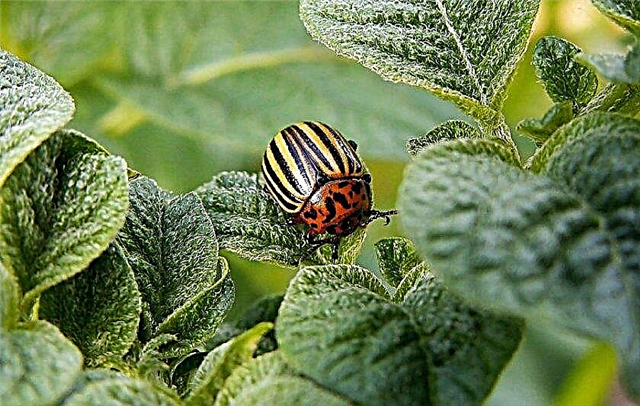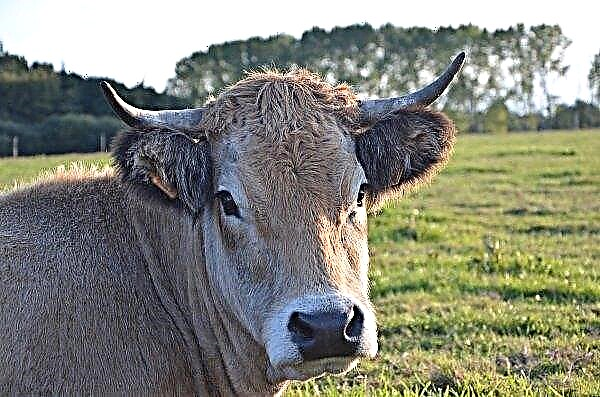One of the most unusual varieties of potatoes is the Idaho variety, from which they prepare an extremely popular dish of the same name throughout the world, better known in our country as “village potatoes”. What is the peculiarity of this variety, and how to grow it properly, let's look.
Selection History and Description
Idaho is an early ripe potato variety suitable for cultivation in regions with moderate climatic conditions. After 60–70 days, the potato fully ripens and is ready for harvesting. The variety gained its popularity due to the large size of the fruits and their excellent taste characteristics. Fruits are large, regular round-shaped root vegetables that contain a large amount of starch and carbohydrates, due to which they are very nutritious.
Did you know? Potatoes can be attributed to poisonous plants. To poison, it is enough to eat 1-2 berries that grow on the stems. Moreover, green tubers, which contain solanine produced under the influence of sunlight, are also considered hazardous to health. To get intoxication, you need to eat about 1 kg of raw green potatoes.
The color of the fruit is beige, the flesh is boiled. The bushes of the culture are quite large, sprawling, have small leaves of a dark green color. The variety is characterized by high productivity, from one hectare, subject to agricultural technology, you can collect 500-600 centners of potatoes. The homeland of the variety is considered to be the United States of America, where potato is used to prepare the traditional Idaho dish, popular around the world. In fact, Idaho is one of the names for the potato variety Russet Burbank, whose predecessor, called Burbank potato, was bred in Lunenburg, Massachusetts, in 1870 by Luther Burbank. A little later, breeders created a descendant of this variety with a red-brown peel and named it Russet Burbank, in honor of the gardener breeder.
In fact, Idaho is one of the names for the potato variety Russet Burbank, whose predecessor, called Burbank potato, was bred in Lunenburg, Massachusetts, in 1870 by Luther Burbank. A little later, breeders created a descendant of this variety with a red-brown peel and named it Russet Burbank, in honor of the gardener breeder.
Pros and cons of the variety
- This variety has several key advantages, among which are:
- early ripening;
- presentation of potatoes, as they have the correct, oval shape;
- high productivity;
- resistance to various ailments;
- excellent taste properties of fruits, lack of wateriness in them;
- wide scope of use.
- Potatoes are also not without shortcomings:
- whimsical to storage conditions, due to the early ripeness of the fruit;
- exactingness to moisturizing and top dressing.
Taste qualities
The Idaho variety is widely used for cooking french fries, chips, and potato in a village at catering points, fast foods, cafes, etc. It belongs to the mealy species, has a coarse-grained, dry structure, rich, pronounced flavor and a wonderful aroma . It is ideal for mashed potatoes, baking, frying.
In addition to high taste, this root crop is very useful. In addition to starch and carbohydrates, it includes fats, protein, B vitamins, ascorbic acid, zinc, magnesium, calcium, copper, and selenium.
Optimal timing and landing features
An early-growing Idaho potato cultivar is recommended to be planted in mid-spring when the soil has warmed up at least + 4 ° С.
At the same time, the following are mandatory conditions for planting a vegetable:
- comfortable weather with a tendency to warm;
- planting well-sprouted and well-warmed seed;
- the presence of the necessary amount of organic fertilizers in the soil, which allow for constant soil heating and protection of uterine tubers from frost;
- conducting a series of activities aimed at protecting the bushes.
Cultivation and care
Despite its “overseas” origin, Idaho potatoes are unpretentious in cultivation and excellent fruit bearing in compliance with the main agricultural principles: high-quality watering, fertilizing, timely weeding and hilling.
Hilling and loosening the soil
Loosening the soil and hilling bushes are some of the most important activities in the cultivation of potatoes. Hilling, that is, regular sprinkling of soil to the base of the bush, contributes to the formation of additional underground stems that serve to form root crops. In addition, a similar procedure “holds together” the bush and prevents the tubers from falling apart.
Hilling measures should be carried out at least twice a season:
- the first - when the bush grows 14-16 cm long;
- second - before flowering, 3-4 weeks after the first.

Watering and fertilizing
One of the negative factors affecting potato growth is drought. Therefore, with a lack of precipitation in the summer, the root crop should be regularly watered. Most of all, the plant needs hydration before and during flowering. Carrying out irrigation measures, it should be borne in mind that one plant will need about 2-3 liters of standing, cold water.
When growing potatoes, you can not do without fertilizing it. The volume and composition of fertilizing must be determined in each individual case individually, analyzing the composition of the soil, and also taking into account the amount of fertilizer applied during planting. Manure diluted in a proportion of 1:10 with water is excellent for feeding. If the soil contains a low percentage of phosphorus, then in the prepared solution, you can add 1.5 tbsp. l superphosphate.
Important! Experienced gardeners are not advised to get too carried away with top dressing, since excess fertilizer in the soil can lead to poor quality fruits. For crops, organic fertilizers are most valuable, in particular, chicken droppings or slurry.
Pest and Disease Control
Idaho has strong immunity and excellent resistance to many ailments.
Nevertheless, if the basic principles of agricultural technology are not observed, it may be affected:
- Colorado potato beetle. The most dangerous parasite that damages tubers and vegetative parts. It multiplies rapidly, has strong immunity, and is capable of traveling vast distances in search of food. To combat the beetle, various biological products and chemicals are used. Reducing the number of pests contributes to timely loosening, hilling of the soil and weeding of weeds.

- Wireworm. This parasite is the larva of a nutcracker. He eats potato tubers, carrots and other vegetable crops with pleasure. The wire forms in the tubers through holes and small dark grooves on the peel, which significantly reduces the aesthetic and taste of the fruit. You can destroy the parasite by combining several methods: processing with special bio- or chemical preparations, the use of agricultural equipment, etc.

- Black leg or bacterial rot. Such ailments most often develop with increased soil moisture. The black leg is manifested in the form of yellowing and falling of leaves, inhibition of the development of the bush. With bacterial rot, white wet spots appear on the tubers, which lead to decay of the entire fetus.

- Potato rot. The disease is one of the most harmful, favorable conditions for which are considered warm and humid weather. It affects root crops during their vegetation and storage.

Harvest Dates
Idaho potatoes are harvested 60–70 days after planting. It is not recommended to overexposure tubers in the soil for a long time, so that they do not lose their attractive aesthetic appearance and taste.
Important! Under adverse climatic conditions, the disease can kill up to 25% of the crop in one season. Without the use of appropriate protective measures, up to 60%.
Root crops are stored in wooden boxes or other containers made of natural materials, and placed in a dry, cool place, with stable temperature indicators +7 ... + 10 ° С. Do not allow vegetables to come in contact with moisture or direct sunlight.
How to cook potatoes at home
Country-style potatoes or Idaho is one of the most popular dishes prepared by eminent world chefs and simple housewives. It has the same demand as french fries, but is less caloric and more useful. Master the preparation of Idaho potatoes is within the power of everyone, even an inexperienced chef. This dish is not fried using vegetable oil, but baked in an oven with many spices. To get an original, tasty and crispy dish, it is recommended to adhere to several rules:
To get an original, tasty and crispy dish, it is recommended to adhere to several rules:
- pick root crops of medium size, of the same name variety;
- during baking, a container with water should be installed on the lower baking sheet, which will allow you to maintain a humid climate in the oven. This way the potato will get crisp but will not be dry in the middle;
- at the initial stage, vegetables must be baked until half cooked at low temperatures, and then at maximum.
The original recipe. It involves boiling the potatoes until half cooked, and then further baking them in the oven.

- Rinse the roots well, dry, cut into equal cubes.
- Dip the vegetables in boiling, slightly salted water for 10 minutes.
- Stretch the pieces, cool a little.
- In a separate container, mix: chopped garlic, olive oil, mustard, spices.
- Mix boiled potatoes with aromatic dressing.
- Lay the pieces separately on a baking sheet, bake until cooked, at 180 ° for approximately 30–35 minutes.
Such a side dish is perfect for vegetables, beef steaks, chicken chop. Also, potatoes can be consumed separately with homemade sauces, dressings.
Did you know? Potatoes belong to the solanaceous family, which also includes tomatoes, eggplant, and even tobacco. They are united by almost identical flowers, stems with a shaggy edge and the ability to accumulate solanine - a toxic substance that is dangerous to human health.
The classic recipe. It involves pre-pickling the vegetable along with the peel in a special dressing of butter and turmeric, due to which, it gets an amazing, very beautiful golden color.

spices (provence herbs)
10 g
- Prepare dressing: add turmeric, salt, tomato paste, herbs, chopped garlic, paprika to the melted butter. Mix all the ingredients well.
- Rinse the potatoes, cut into equal cubes.
- Dip the pieces for 3 minutes in boiling water, stretch, cool slightly.
- Pour the vegetables with the cooked marinade, let stand 25 minutes.
- Put the pickled potato slices on a baking sheet.
- Bake vegetables for the first 15 minutes at a temperature of 150 °, then at 200 ° C for another 20 minutes.
Sweet and sour sauce or tender creamy sauce with mushrooms will be perfect for ready golden pieces of potato. This legendary recipe has long won the hearts of all gourmets of the world. Idaho high-yielding potatoes can be your favorite among the other varieties.
 It is unpretentious in cultivation, has resistance to many diseases, is able to please with excellent crops. The tubers are distinguished by their excellent taste and are ideally suited for the preparation of delicious Selyansky potatoes.
It is unpretentious in cultivation, has resistance to many diseases, is able to please with excellent crops. The tubers are distinguished by their excellent taste and are ideally suited for the preparation of delicious Selyansky potatoes.
















